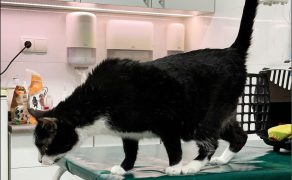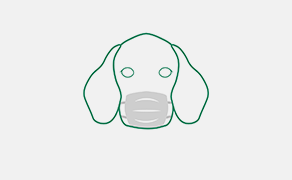Tandem lekarz weterynarii – behawiorysta – wybór czy konieczność?
Piśmiennictwo
- Demontigny-Bédard I., Frank D.: Developing a Plan to Treat Behavior Disorders. „Vet Clin North Am Small Anim Pract”, 2018, 48 (3), 351-365. DOI: 10.1016/j.cvsm.2017.12.004.
- Bergman L., Hart B.L., Bain M., Cliff K.: Evaluation of urine marking by cats as a model for understanding veterinary diagnostic and treatment approaches and client attitudes. ”J Am Vet Med Assoc”, 2002, 221 (9), 1282-1286. DOI: 10.2460/javma.2002.221.1282.
- Hevern M.E.: Welfare worries: a preliminary, cross-sectional study of general practice, small animal veterinarians perceptions and management of canine and feline behaviour problems. ”Aust Vet J”, 2022, 100 (8), 377-387. DOI: 10.1111/avj.13168.
- Goins M., Nicholson S., Hanlon A.: Veterinary Professionals’ Understanding of Common Feline Behavioural Problems and the Availability of „Cat Friendly” Practices in Ireland. „Animals (Basel)”, 2019, 9 (12), 1112. DOI: 10.3390/ani9121112.
- Ramos D., Reche-Junior A., Hirai Y., Mills D.S.: Feline behaviour problems in Brazil: a review of 155 referral cases. „Vet Rec”, 2020, 186 (16):e9. DOI: 10.1136/vr.105462.
- Overall K.L.: Medical differentials with potential behavioral manifestations. ”Vet Clin North Am Small Anim Pract”, 2003, 33 (2), 213-229. DOI: 10.1016/s0195-5616(02)00103-1.
- Schroll S., Dehasse J.: Zaburzenia zachowania kotów. Edra Urban & Partner, Wrocław 2018.
- Schroll S, Dehasse J.: Zaburzenia zachowania psów. Edra Urban & Partner, Wrocław 2019.
- Zaniewska-Wojtków Z., Wojtków P.: Słuchając psa. Wydawnictwo Buchmann, Warszawa 2019.
- Silverman J, Kurtz S, Draper J.: Umiejętności komunikowania się z pacjentami. „Medycyna Praktyczna”, Kraków 2018.
- Zaniewska-Wojtków Z., Wojtków P.: Szczeka, merda, mówi. Jak być najlepszym człowiekiem swojego psa. Wydawnictwo Znak Literanova, Kraków 2021.
- Suchman A.L.: Research on patient-clinician relationships: celebrating success and identifying the next scope of work. „J Gen Intern Med”, 2003, 18 (8), 677-678. DOI: 10.1046/j.1525-1497.2003.30615.x.
- Silverman J., Kurtz S., Draper J.: Skills for Communicating with Patients. Radcliffe Medical Press, Oxford 1998.
- Silverman J., Kurtz S., Draper J.: Skills for Communicating with Patients (3rd ed.). CRC Press, London 2013. DOI: https://doi.org/10.1201/9781910227268.
- Hecker K.G., Adams C.L., Coe J.B.: Assessment of first-year veterinary students’ communication skills using an objective structured clinical examination: the importance of context. ”J Vet Med Educ”, 2012, 39 (3), 304-310. DOI: 10.3138/jvme.0312.022R.
lek. wet. Marta Miszczak
IV rok Interdyscyplinarnej
Szkoły Doktorskiej ProHum
Zakład Chorób Zakaźnych Zwierząt
i Administracji Weterynaryjnej
Katedra Epizootiologii
z Kliniką Ptaków i Zwierząt Egzotycznych
Wydział Medycyny Weterynaryjnej
Uniwersytet Przyrodniczy we Wrocławiu
pl. Grunwaldzki 45, 50-366 Wrocław
Mogą zainteresować Cię również
Znajdź swoją kategorię
2813 praktycznych artykułów - 324 ekspertów - 22 kategorii tematycznych
Weterynaria w Terenie

Praktyka w terenie – jak zabezpieczyć się na wypadek stanów zagrożenia życia lub zdrowia zwierzęcia
Piśmiennictwo mec. Anna SłowińskaVox Poland Pomoc PrawnaSzczecin Facebook0Tweet0LinkedIn0

Choroby racic jako ważna przyczyna brakowania krów w stadzie bydła mlecznego
Czynniki środowiskowe Zbiór czynników wchodzących w zakres określany jako „środowiskowy” jest szeroki i niezamknięty. Wpływ środowiska w przypadku chorób racic pozostaje kluczowy. Zarówno terapia, jak i prewencja chorób racic pozostają nieefektywne, jeśli nie połączy się ich z kierunkową analizą środowiska, w jakim funkcjonuje bydło, zidentyfikowaniem krytycznych punktów stwarzających zagrożenie i wprowadzeniem procedur naprawczych. Odporność na […]

Czynniki wpływające na kolonizację mikrobiomu i dojrzałość układu pokarmowego prosiąt oraz jego prawidłowe funkcjonowanie
Ze względu na stymulację układu odpornościowego aminokwasy są najczęściej atakowanym składnikiem odżywczym, a prosięta mogą mieć zwiększone zapotrzebowanie na aminokwasy podczas odsadzenia (49). Dodatek niektórych aminokwasów do paszy może zwiększyć poziom czynników przeciwwydzielniczych w osoczu i zmniejszyć częstość występowania biegunki u prosiąt odsadzonych (30). Badania wykazały, że gdy układ odpornościowy jest atakowany, na przykład podczas […]

Opieka stomatologiczna nad starszymi końmi
Wklęsłe powierzchnie trące U koni w wieku powyżej 20 lat powierzchnie trące zębów policzkowych zaczynają przybierać wklęsły kształt i tracą wypukłe listewki poprzeczne. Najwcześniej zmiany te pojawiają się w pierwszych górnych trzonowcach (109 i 209), a z czasem obejmują kolejne zęby. Zmniejsza to w znaczący sposób powierzchnię rozcierania pokarmu. Jeśli sytuacja dotyczy wielu zębów, a […]

Praktyka w terenie – jak zabezpieczyć się na wypadek stanów zagrożenia życia lub zdrowia zwierzęcia
Piśmiennictwo mec. Anna SłowińskaVox Poland Pomoc PrawnaSzczecin Facebook0Tweet0LinkedIn0

Wiek ma ogromne znaczenie podczas stawiania diagnozy
Lek. wet. Justyna Domagała tytuł inżyniera zootechniki uzyskała w 2016 r., a tytuł lekarza weterynarii – w 2019 r. na Uniwersytecie Przyrodniczym we Wrocławiu. Po studiach swoją wiedzę poszerzała podczas stażu w Szpitalu dla Koni Equivet, w którym później uzyskała zatrudnienie. W latach 2021-2024 swoją pracę skupiała na internistycznym leczeniu koni oraz pogłębianiu wiedzy na […]

Echa 32. Kongresu Bujatrycznego w Cancun
Profilaktyka Kongres był również okazją do zaprezentowania kilku przełomowych produktów immunologicznych, które mają szansę wprowadzić na nowe tory prewencję znanych od lat jednostek chorobowych, sprawiających wiele kłopotów z punktu widzenia odchowu cieląt czy rozrodu. Mowa tu konkretnie o trzech nowych szczepionkach mających zastosowanie w profilaktyce Mycoplasma bovis, Cryptosporidium parvum czy wirusowej biegunki bydła (BVD). Nie […]
































































